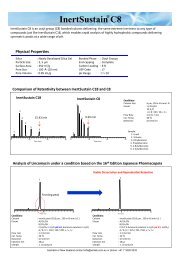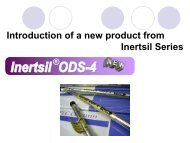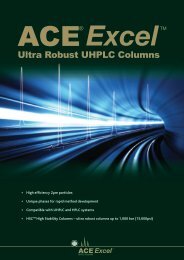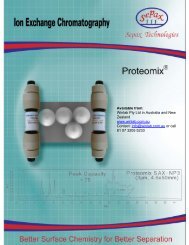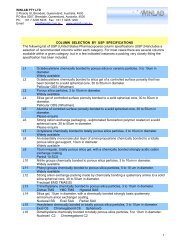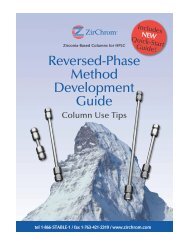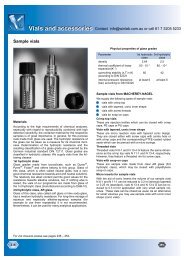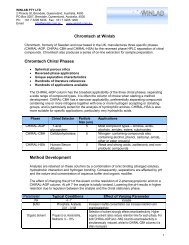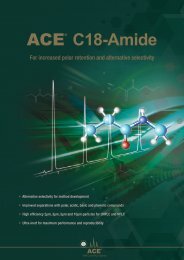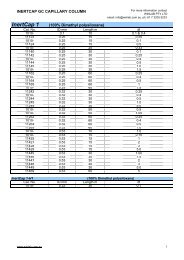ACE Super C18 Brochure - Winlab.com.au
ACE Super C18 Brochure - Winlab.com.au
ACE Super C18 Brochure - Winlab.com.au
- No tags were found...
You also want an ePaper? Increase the reach of your titles
YUMPU automatically turns print PDFs into web optimized ePapers that Google loves.
<strong>ACE</strong> <strong>Super</strong><strong>C18</strong> Ultra-Inert UHPLC and HPLC Columns with Extended pH StabilityEncapsulated Bonding Technology (EBT) for Improved Chromatography and StabilityTraditional <strong>C18</strong> Bonding<strong>ACE</strong> <strong>Super</strong><strong>C18</strong> with Encapsulated Bonding Technology (EBT)<strong>C18</strong>Endcapping groupUnbonded silanol group<strong>C18</strong>■■■The unique Encapsulated Bonding Technology (EBT) developed for <strong>ACE</strong> <strong>Super</strong><strong>C18</strong> columns dramatically increasesligand coverage of the silica surface and effectively eliminates the effect of unbonded silanol groups from separations.This higher ligand coverage results in improved inertness, chromatographic performance and stability.Under aggressive acidic conditions (see Figure 1) <strong>ACE</strong> <strong>Super</strong><strong>C18</strong> is highly resistant to ligand cleavage, due to a<strong>com</strong>bination of the Encapsulated Bonding Technology (EBT) and ultra-inert <strong>ACE</strong> silica. Many <strong>C18</strong> bonded columnswill exhibit ligand cleavage under acidic conditions, resulting in retention shifts and/or increased peak tailing.Under basic conditions with LC/MS <strong>com</strong>patible mobile phases (see Figure 2), the Encapsulated Bonding Technology(EBT) shields the <strong>ACE</strong> <strong>Super</strong><strong>C18</strong> surface from dissolution whilst maintaining excellent chromatographic performance.Traditional <strong>C18</strong> bonded silica columns are prone to silica dissolution under such aggressive conditions, which can resultin premature column deterioration.Figure 1 - Excellent Acidic Stability at pH 1.8Application # 1511Acidic flow conditionsColumn: <strong>ACE</strong> Excel 2µm <strong>Super</strong><strong>C18</strong>, 50 x 2.1mmMobile Phase: 50:50 MeOH/0.1% TFA in H 2 O (pH 1.8)Temperature: 40°C Flow Rate: 0.20ml/minFigure 2 - Excellent Basic Stability at pH 10.7Application # 1512Basic flow conditionsColumn: <strong>ACE</strong> Excel 3µm <strong>Super</strong><strong>C18</strong>, 150 x 4.6mmMobile Phase: 50:50 MeCN/0.1% NH 3 in H 2 O (pH 10.7)Temperature: 40°C Flow Rate: 1.00ml/minDay 11 2k (phenanthrene) = 16.91Day 112N0.5 (biphenyl) = 169,100pl/m3453450 1 2 3 4 5 6 7 8 9 10 11 12 13 140 1 2 3 4 5 6 7 8 9 10 11 12 13 14Acidic Mobile Phase (pH 1.8)(continuous flow)>20,000 column volumes>2,000 injectionsBasic Mobile Phase (pH 10.7)(continuous flow)>20,000 column volumes>2,000 injectionsDay 301 234k (phenanthrene) = 16.855Day 30123N0.5 (biphenyl) = 168,700pl/m450 1 2 3 4 5 6 7 8 9 10 11 12 13 14Time - MinutesEvaluation conditionsSample: 1) uracil 2) dimethyl phthalate 3) toluene 4) biphenyl 5) phenanthreneMobile Phase: 70:30 MeOH:H 2 OTemperature: 22°C Flow Rate: 0.20ml/min Wavelength: 254nm0 1 2 3 4 5 6 7 8 9 10 11 12 13 14Time - MinutesEvaluation conditionsSample: 1) uracil 2) dimethyl phthalate 3) toluene 4) biphenyl 5) phenanthreneMobile Phase: 80:20 MeOH:H 2 OTemperature: 22°C Flow Rate: 1.00ml/min Wavelength: 254nm2www.ace-hplc.<strong>com</strong>Australia & New Zealand contact: infor@winlab.<strong>com</strong>.<strong>au</strong> or call +61 7 3205 5233
<strong>ACE</strong> <strong>Super</strong><strong>C18</strong> Ultra-Inert UHPLC and HPLC Columns with Extended pH StabilityComparison of Column Inertness at Intermediate pH■ Leading column brands in 50 x 2.1mm LC/MS <strong>com</strong>patible dimensions at pH 5.8■ Silica, Hybrid and <strong>Super</strong>ficially Porous particle technologies <strong>com</strong>pared■ Comparison of column efficiency for pyridine, a basic molecule■ Efficiency measured at 5% peak height to account for peak tailing effectsPeak Efficiency ComparisonReproduced with kind permission of The Open University, UK.Application # 1513<strong>ACE</strong> Excel 2 <strong>Super</strong><strong>C18</strong>Zorbax Eclipse 1.8 XDB <strong>C18</strong>42,400pl/m68,900pl/mLower TailingAgilent Poroshell 2.7 120 EC <strong>C18</strong>41,900pl/mWaters XBridge 2.5 BEH <strong>C18</strong> XP30,800pl/mWaters Acquity 1.7 BEH <strong>C18</strong>30,700pl/mPhenomenex Kinetex 2.6 <strong>C18</strong>26,800pl/mWaters XBridge 2.5 <strong>C18</strong>25,600pl/mPhenomenex Luna 2.5 <strong>C18</strong>(2) HST a21,900pl/mNucleoshell 2.7 RP18 a21,200pl/mPhenomenex Kinetex 1.7 <strong>C18</strong>20,700pl/mZorbax Extend 1.8 <strong>C18</strong>Thermo Accucore 2.6 <strong>C18</strong>10,300pl/m7,300pl/mHigher Tailing0 20,000 40,000 60,000 80,000 100,000N0.05 (pyridine) (plates/m)<strong>ACE</strong> Excel 2 <strong>Super</strong><strong>C18</strong>(fully porous ultra-inert silica)N 0.05 (pyr) = 68,900pl/mWaters ACQUITY 1.7 BEH <strong>C18</strong>(hybrid particle)N 0.05 (pyr) = 30,700pl/mPhenomenex Kinetex 1.7 <strong>C18</strong>(core-shell particle)N 0.05 (pyr) = 20,700pl/m2223313110 1 2 3 4 5 0 1 2 3 4 5 0 1 2 3 4 5Time - Minutes Time - Minutes Time - MinutesColumn Dimensions: 50 x 2.1mm ( a 50 x 2.0mm) Sample: 1) uracil 2) pyridine 3) phenol Mobile Phase: 30:70 MeOH/10mM NH 4 OAc in H 2 O (pH 5.8)Flow Rate: 0.20ml/min Temperature: 22°C Wavelength: 254nmComparative data may not be representative of all applications. Please see page 5 for acknowledgement of trademarks.Conclusion:Significant differences in efficiency, peak shape and selectivity are seen when analysing pyridine– a basic molecule.Increased tailing and retention, <strong>com</strong>bined with reduced efficiency, are indicative of undesirablesecondary interactions between pyridine and silanol groups on the stationary phase surface.These interactions can also result in poor column reproducibility.<strong>ACE</strong> <strong>C18</strong> columns have gained a well deserved reputation for providing excellent efficiency, peakshape and reproducibility. <strong>ACE</strong> <strong>Super</strong><strong>C18</strong> columns further build upon this proven reputation toprovide the analyst with even better chromatographic performance across an extended range ofpH conditions under LC/MS <strong>com</strong>patible conditions.Si-OH<strong>ACE</strong> ® StationaryPhases VirtuallyEliminate theNegative Effectsof Silanols on UHPLC& HPLC Separations3www.ace-hplc.<strong>com</strong>Australia & New Zealand contact: infor@winlab.<strong>com</strong>.<strong>au</strong> or call +61 7 3205 5233



